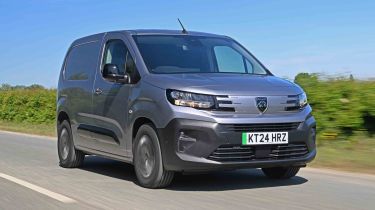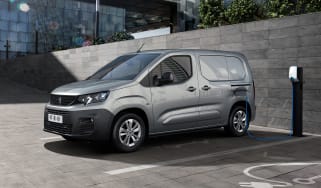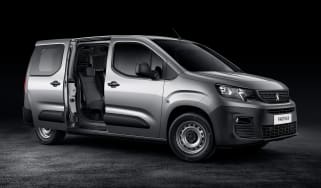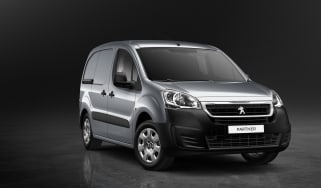Peugeot Partner van review
The Peugeot Partner is a small van front-runner, with plenty of versatility and car-like tech
Our opinion on the Peugeot Partner
The Peugeot Partner might be one of a handful of near-identical Stellantis group vans, but it stands out more than its rivals thanks to its iCockpit interior layout. This adds a compact steering wheel and high-set instruments for a sporty feel. Elsewhere, the Partner offers competitive cargo volume and payloads along with frugal diesel engines and an efficient all-electric option in the E-Partner.
About the Peugeot Partner
The Peugeot Partner is a front-runner in the small van sector. The latest version, that was first introduced in 2018 and facelifted in late 2024, features car-derived tech and easy-going driving manners. Practicality is excellent, too, with payload weights of up to three quarters of a tonne available. But the real advances come in the cabin, where Peugeot has made the Partner more user-friendly than before.
There's more safety kit, plenty of useful and practical features, while the choice of efficient diesels or an electric motor help to keep costs down. Driving comfort is improved, too, while a variety of trim levels mean there should be a Partner to suit most small van customer needs.
While the last Peugeot Partner was essentially a rebadge of the Citroen Berlingo, it was Peugeot that took the lead when it came to producing this new model. Under the skin, the rear section of the van's platform is a development of the previous-generation Partner, while the front is an adaptation of the PSA Group's EMP2 car chassis. That means Peugeot was able to kit the Partner out with a range of cutting-edge convenience and safety tech that hadn't been seen in the small van class before.
Used - available now

2026 Toyota
Corolla
9,500 milesAutomaticPetrol1.8L
Cash £23,421
2021 Vauxhall
Corsa
17,710 milesManualPetrol1.2L
Cash £11,999
2023 Tesla
Model 3
55,000 milesAutomaticElectric
Cash £18,888
2023 Tesla
Model Y Premium
19,000 milesAutomaticElectric
Cash £24,444Since Peugeot is part of the PSA Group, the Partner has 'partner' vans that use the same technology. The Citroen Berlingo Van has long been a sister model to the Peugeot, while PSA Group's takeover of General Motors' European brands mean the current Vauxhall Combo also uses the same tech, while a technology partnership means that the Toyota Proace City is essentially the same van. In addition, the Peugeot Rifter is the MPV variant of the Partner, having ditched the Partner Tepee name. All these vans use the same body, but the designers have created a short bonnet design so that all four models can have distinctly different front end designs to separate them.
There are two lengths of Peugeot Partner, called Standard and Long, while a single roof height is offered. The Partner Crew Van is also on offer exclusively with the Long bodystyle and gets a five-seat layout. It features a three-seat rear bench and a mesh bulkhead, a combination that can be folded and moved forward to create more cargo space if it's needed.
The Partner range is powered by Peugeot's BlueHDi diesel in 100 and 130 guises or an electric motor in the E-Partner. It's the same diesel engine you'll find in the Peugeot car range, with the lower-powered engines featuring a five-speed manual, while the 130 has an eight-speed auto. All diesel models come with stop-start as standard.
Electric versions get a 52kWh battery (a 2kWh improvement from pre-facelift) and a 134bhp electric motor powering the front wheels via single forward and reverse gears.
There are three trim levels available, the fleet-minded Professional, the Professional Plus and the Asphalt, which offer car-like levels of kit. While these trim levels have different names to Citroen's, prices and specifications for the Partner are virtually identical to the Berlingo Van across the board.
That means the standard kit is essentially the same, although the other main difference between the Partner and the other vans is its i-Cockpit layout. This sees a small steering wheel fitted, with the dashboard dials set above it. It looks interesting and feels sporty, but it’s a layout that some drivers might find awkward, so it's well worth trying before you buy.
All vans get offset double rear doors, a full steel bulkhead, a single sliding side door (twin doors are standard on Long and Crew vans), a reach and rake adjustable steering wheel, auto lights, six load hooks in the load area and Bluetooth, among others.
Professional-Plus and Asphalt models all get a three-seat cab layout. This Multi-Flex folding seat also sees an electric parking brake added - which helps take some strain out of driving - while the seats flip and fold to create more storage. Also included is a through-load facility for the bulkhead that allows longer items to be carried.
Professional-Plus vans also get a HD 10-inch touchscreen DAB radio with Apple CarPlay and Android Auto, plus two USB sockets. On top of this Asphalt vans add body coloured bumpers, alloy wheels, sat-nav and rear and nearside cameras, although all of these extras can be added to lower spec models from the extensive options list.
Peugeot offers a variety of packs that bundle options together into better value packages, from a Cargo Pack adding LED lighting, extra storage hooks and a 12-volt socket in the loadspace to the Drive Assist Pack with adaptive cruise control and driver aids to help with long motorway trips.
MPG, CO2 and Running Costs

|
Pros |
|
| Cons |
|
The Peugeot Partner has a similar model line-up and price range as the Citroen Berlingo Van. Prices start from around £21,500 ex-VAT, while the Long model starts from just under £22,500 ex-VAT. The most expensive diesel Asphalt Long model comes in at around £27,000 ex-VAT, although Peugeot offers plenty of options that can bump these prices up significantly. The E-Partner is more expensive, starting from a similar price to the top diesel version and topping out at just over £29,000.
Economy is the Partner's strong point thanks to its diesel engine range. Under the WLTP test cycle, the BlueHDi 100 - the engine we'd go for - has a best combined economy figure of 54.4mpg, while the BlueHDi 130 with auto gearbox manages 51.9mpg. This makes the BlueHDi 100 pretty much the default choice, unless you want an auto gearbox.
All vans come with a 50-litre fuel tank, while the AdBlue tank measures at 17 litres, and the van's trip computer will warn you when this needs refilling.
Electric range, battery life and charge time
The arrival of a 52kWh battery for the facelift saw its range figure increase to 213 miles, which is impressive for a small electric van - even if the E-Berlingo can manage 220 miles. It should also be able to drive for closer to 300 miles in the city, which clearly shows where the Peugeot is most efficient. Lower speeds with plenty of regenerative braking really suit the E-Partner, while sustained high speeds bring down its range more quickly.
Found in the same place as the diesel filler, the CCS charging socket can reach peak charging speeds of 100kW at a DC rapid charger, for a zero to 80 per cent top up in half an hour.
Using an AC wallbox, the Partner can fully charge in seven hours 30 minutes at 7.4kW or five hours at 11kW (if an optional £350 onboard charger upgrade is fitted). Plug in to a three-pin domestic socket and it’ll take a huge 31 hours to recharge.
Load space and practicality
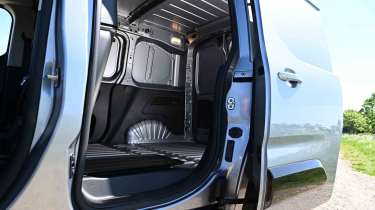
|
Pros |
|
| Cons |
|
The Peugeot Partner has a development of the old Partner's platform at the rear, although a comprehensive redesign has made more space and increased payload weights. Different models have different payload weights, but these range from 691kg for the E-Partner Crew Long, up to 984kg for the BlueHDi 130 in Standard body guise. The Crew Van has a payload from 642kg in the E-Partner to 840kg with a diesel engine.
Cargo volume for the Standard van is 3.3 cubic metres, while vans with the Multi-Flex front seat have a combined maximum of 3.8 cubic metres, with an extra 600 litres of space when the front passenger seat is folded and the bulkhead door is open. Go for a Long van, and cargo volume is 3.9 cubic metres as standard, and 4.4 cubic metres in Multi-Flex mode. The Crew Van offers 1.8 cubic metres with all five seats in place, 3.5 cubic metres with the bulkhead forward in two-seat mode, or up to 4.0 cubic metres with the rear seats folded and the bulkhead open.
In terms of dimensions, the cargo area has 1,229mm between the wheelarches, so it's wide enough for a Europallet to fit between them. The maximum load width is 1,630mm (1,527mm for Long), while the load height is 1,200mm (1,270mm for the Long/Crew vans). There's a load lip that's 547mm high, rising to 560mm for the Long model. Finally, there's a load length of 1,817mm for the Standard van and 2,167mm for the Long version, which has a longer wheelbase and an extended rear overhang to create more space. The Multi-Flex through-load facility increases this to 3,090mm and 3,440mm respectively. Multi-Flex also adds a sturdy vinyl bag that helps prevent long items from damaging the interior.
Access to the load area is via 60:40 split rear doors that offer an opening of 1,196mm high and a load width that ranges from a maximum of 1,241mm to a 1,087mm minimum. The side door slides open to create an opening that measures 1,072mm high and a minimum of 641mm wide. The Standard van has a single sliding side door, while the Long van has double doors. You can add a second door to the Standard van, and all doors can be had with windows, as can the steel bulkhead. The Crew Van comes with steel side doors as standard, with window glass available as an option. Peugeot doesn't currently offer a top-hinged tailgate on the Partner.
Reliability and Safety
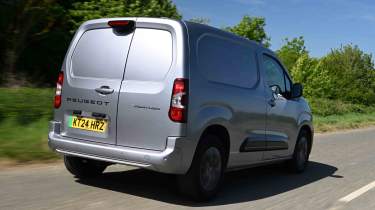
|
Pros |
|
| Cons |
|
The Peugeot Partner uses lots of technology shared with other vans and cars within the Stellantis range, so we don’t expect any serious reliability issues. This goes for the E-Partner too, which should also be cheaper to maintain and service.
Peugeot’s use of EMP2 underpinnings means Peugeot has been able to offer a range of safety features that are more commonly seen on passenger cars. For the facelift, standard safety kit now includes a driver's airbag along with passenger, side and curtain airbags that were previously optional. There’s also a full-height steel bulkhead to separate the cargo and passenger areas, electronic stability control, traction control, hill start assist and emergency brake assist.
All vans get a full-size spare wheel, while tyre pressure monitors are also fitted. Peugeot's Drive Assist Pack would've been unheard of in a van even just a few years ago, but adds adaptive cruise control that can stop and start the van in traffic (with the automatic gearbox or electric powertrain), lane positioning, automatic emergency braking and a leather heated steering wheel.
Van security includes remote central locking with deadlocks and separate load area opening and immobiliser, while higher spec vans get an alarm that can also inform you if the van has suffered from an attempted break-in while you're away.
Driving and Performance

|
Pros |
|
| Cons |
|
On the road, the Peugeot Partner is night and day when compared to the old model. Where that van was choppy and bouncy and not much fun, the latest model rides well and is fairly engaging. Part of the reason for this is the iCockpit cabin layout, which adds a small steering wheel to give the Partner a sportier touch.
The engine range only really lives up to the chassis' sporty potential with the BlueHDi 130 motor. This has a good amount of power for hauling big loads, and it feels sprightly enough to give the Partner a decent turn of speed.
The smaller BlueHDi 100 engine is still decent, but not quite as punchy even when lightly loaded. It comes with a five-speed manual gearbox, and the widely spaced ratios mean it doesn't have the urgency of the 130 engine. It’s a bit noisier, too, so is more suited to leisurely driving, especially since acceleration isn't that brisk.
Again, this engine isn't helped by the gearbox it uses. The five-speed unit is vague to shift, but once you're in tune with it, this shouldn't be too much of an issue.
Town driving, visibility and parking
The Partner has clearly been tuned for urban driving, with light steering and features like standard rear parking sensors to make reversing into tight spaces easier. The aforementioned manual gearbox can be a bit of a pain, so the automatic feels like a nice upgrade, and it works better than before with improved response at junctions and roundabouts.
With just a forward and reverse gear, smooth responses and regenerative braking, the E-Partner is even better suited to urban driving. Instead of a single ‘B’ mode, the facelift also introduced paddles behind the steering wheel to adjust the level of regenerative braking. However, this still isn’t strong enough for one-pedal driving where you barely need to touch the brake pedal.
Motorway driving and long-distance comfort
As well as being easier to drive around town, the E-Partner is also smoother and quieter at higher speeds, with less vibration and noise than its diesel equivalent. The weight of the battery also aids the ride comfort, making it a bit more settled when there’s only a light load on board.
Cab and Interior

|
Pros |
|
| Cons |
|
With everything so closely matched between the Peugeot Partner and Citroen Berlingo Van, as well as the Vauxhall Combo and Toyota Proace City, the one thing that could clinch your decision could be the dashboard layout. The Partner uses the i-Cockpit layout that has been seen in models such as the 308 and 3008, so you get a small, low-set steering wheel and dials positioned high on the dashboard in the driver's line of sight. In comparison, the other three vans use a larger wheel with the dials set behind.
The Peugeot's layout takes some getting used to, and it might not be as easy to get a comfortable driving position where you can see all the instruments ahead of you - it really is a case of try before you buy to see if you can get on with the Partner's layout.
The rest of the cabin is reasonably well laid out, with the infotainment positioned in the middle of the dashboard The gearlever is also located on the dashboard to give more legroom below, but the fact it protrudes makes kneeroom tight for a middle passenger. The controls are easy to use, although the climate controls are recessed slightly under the air vents which makes them a bit hard to read.
Cabin space is good. The basic van is a two-seater with lots of room, although there's no cabin storage between the front seats. All vans get a reach and rake adjustable steering wheel, although you may find the small wheel is positioned lower than you like if you want to read the dials. There are overhead storage shelves, while the three-seat Multi-Flex layout adds two passenger seats. Space is a bit tight if you're travelling three-up - especially legroom for middle seat passengers, but the added flexibility that the system provides means it's still a worthwhile addition.
Storage elsewhere is similar to its sister vans, with two gloveboxes, including a huge upper box that can fit a 15-inch laptop with ease. However, while the dash layout in the Berlingo Van and Combo means there's an extra lidded storage area above the dials, the i-Cockpit layout foregoes this, so you get a small storage tray ahead of the dials instead.
Power is supplied by two 12V sockets and twin USB connections, while Bluetooth connectivity and an audio jack are also included.
Infotainment, sat-nav and stereo
The entry-level Partner doesn’t get an infotainment display, but you’ll still be able to link a smartphone via Bluetooth and control audio via the steering wheel buttons. The Professional-Plus introduces a 10-inch HD touchscreen with smartphone mirroring and a 10-inch instrument cluster, so it feels quite a bit more car-like and advanced. We found the system quick to respond and reasonably intuitive. The physical volume and settings button are also handy, allowing quicker access to some key functions.
Buying and owning
Every Partner is pretty well equipped, but businesses looking to operate the Partner further afield should find the added benefit of a touchscreen infotainment setup with the addition of WiFi and connected services a good reason to upgrade to the mid-spec trim.
For anyone driving well under 200 miles per day around their local area, the E-Partner should make lots of sense - it’s smooth, easy to drive and cheaper to run. For those with frequent motorway miles or the need to tow more than 750kg, a diesel version will make more sense.
Peugeot Partner alternatives
As well as its Citroen Dispatch, Vauxhall Combo, Fiat Doblo and Toyota Proace City sister models, the Peugeot Partner can count the VW Caddy and Ford Transit Courier as its main rivals, while other rivals such as the Renault Kangoo and Mercedes Citan also have their merits.
Deciding which of the Stellantis small vans to pick might appear tricky, as they all share virtually identical specifications. In reality, it’s likely to come down to which one has the best finance deal or most convenient location for maintenance to suit each customer. You’ll also need to factor in whether the Partner’s iCockpit layout is for you, as its sister models have a more conventional setup and bigger steering wheel.
Van dimensions | |||
| Body style | Height | Width | Length |
| Standard | 1,796mm | 1,848mm | 4,403mm |
| Long | 1,812mm | 1,848mm | 4,753mm |
| Crew van | 1,812mm | 1,848mm | 4,753mm |
Load area dimensions | ||||
| Body style | Height | Width | Length | Volume |
| Standard | 1,200mm | 1,630mm | 1,817mm (3,090mm) | 3.3m3 (3.8m3) |
| Long | 1,270mm | 1,527mm | 2,167mm (3,440mm) | 3.9m3 (4.4m3) |
| Crew van | 1,243mm | 1,527mm | 1,450mm | 1.8m3-4.0m3 |
(Width between wheel arches: 1,229mm)
Frequently Asked Questions
The Partner is certainly worthy of consideration in the small van class. It boasts plenty of cargo space, handy features like a through-loading steel bulkhead and it’s affordable. That’s not only thanks to its starting price, but also the frugal nature of its diesel and electric powertrains.
